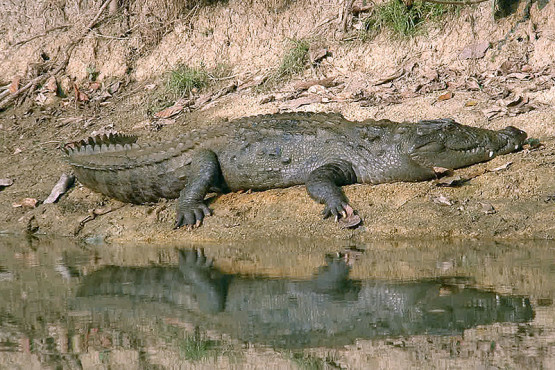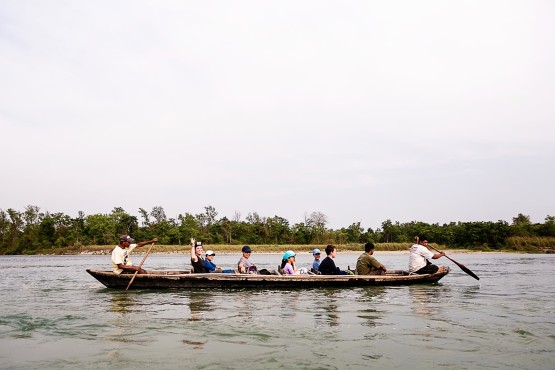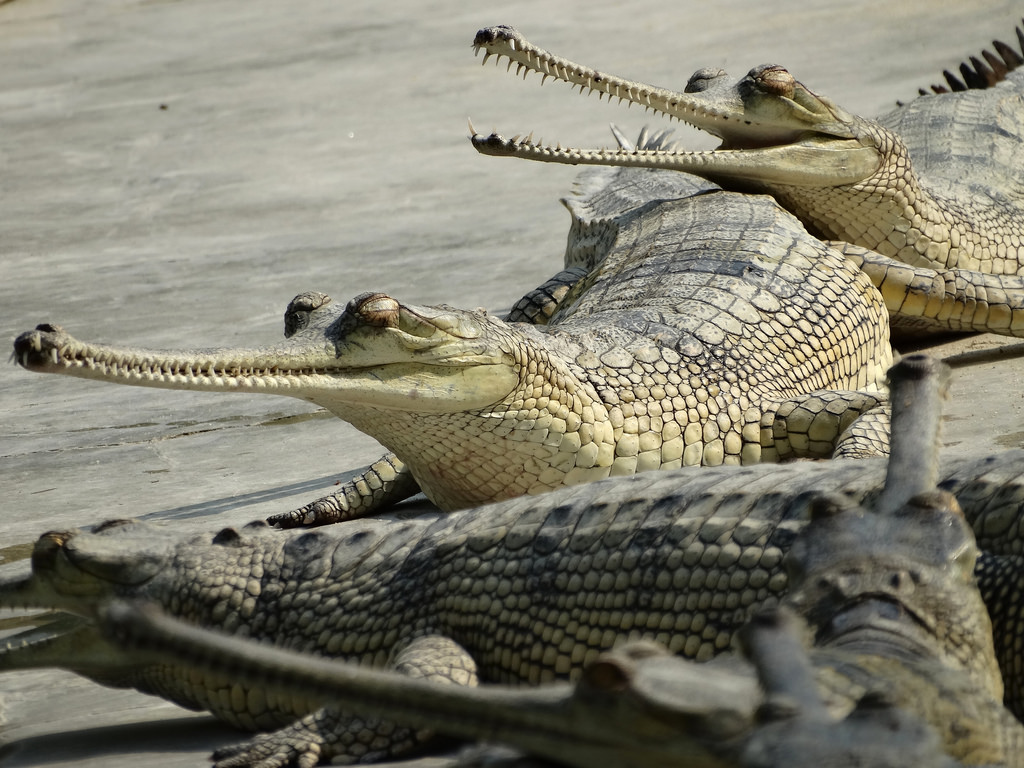Established in 1973, Chitwan National Park is the first national park of Nepal. Formerly, the park used to be known as the “Royal Chitwan National Park.” It was designated as the World Heritage Site in the year 1984. The park is spread in the area of 952.63 km2. It is located in the subtropical Inner Terai lowlands of south-central Nepal covering the area of the district of Chitwan, Nawalparasi, Parsa, and Makwanpur. The altitude of the park ranges from about 100 meters/330 feet in the river valley to the height of 815 meters/2,674 feet in the Churia Hills.
In the north and west side of the Chitwan National Park, the Narayani-Rapti River system forms a natural boundary to human settlements. The park is adjacent to Parsa National Park in the east and in the south lies the Indian Tiger Reserve, Valmiki National Park. Altogether, the three protected area is of 2,075 km2, and they represent the Tiger Conservation Unit (TCU) Chitwan-Parsa-Valmiki.
Climate and Vegetation of Chitwan National Park
The climate of Chitwan is characterized by tropical monsoon with high humidity throughout the year. Located in the central climatic zone of the Himalayas, the monsoon starts in the mid-June and ends in the late September. Then after the mid-October, the monsoon clouds go away, humidity drops off, and the temperature gradually falls to a moderate level.
The vegetation of Chitwan National Park is of the Inner Terai which is a Himalayan subtropical broadleaf forest with predominantly sal trees covering about 70% area of the park. In the southern side of the Churia Hills sal, the vegetation is interspersed with chir pine. The northern slope sal associates with smaller flowering trees and shrub species. Because of the natural causes like bushfires, flooding, and erosion, there is an ever-changing mosaic of riverine forest and grasslands along the river banks. About 20% of the park area is covered by Terai-Duar savanna and grasslands.
Wildlife and Plants of Chitwan National Park
With the availability of a wide range of vegetation, the park is inhabited by many wildlife. The protected area has more than 700 species of wildlife, and the butterfly, moth, and insects are yet to be surveyed. There are 68 species of mammals which includes Bengal tigers, one-horned rhinoceros, and leopards. There are 17 species of snakes, starred tortoise and monitor lizards without counting king cobra and rock python. There are 113 recorded species of fish and mugger crocodiles. Also, as per the survey in 2006, there are 543 species of birds in the park. Apart from the resident birds of the park, about 160 migrating and vagrant species arrive in Chitwan in the autumn season.
Rosewood, axlewood, rhino apple trees, catechu, kapok, elephant apple grey downy balsam, gooseberry, velvety beautyberry are some of the plants in the Chitwan National Park. In the park, there are some of the world’s tallest grasses like elephant grass called Saccharum ravennae, giant cane, khagra reed and several species of true grasses.

Things to do in Chitwan National Park
Jungle Safari
Chitwan National Park is the popular destination for national as well as international tourist. And, with the wide range of flora and fauna, jungle safari is a very popular activity. Jungle Safari done by almost all who have been to the Chitwan National Park, as it is a fun and adventurous which lets you explore and experience things on your own.
There are some choices in how you are willing to take over this adventure. You can do the Jungle Safari by walking. Most of the tourist who loves nature go for safari by walking as nature walk will give you the best opportunity to observe the wildlife and vegetation from a closer distance. However, guides are mandatory for jungle safari. But, if you are not a walking type of person then, there is an option for you as well, you can go for jeep safari. In jeep safari, you can set at the back of the jeep comfortably and enjoy the view of wildlife you encounter on your way. One of the essential tools to carry in jungle safari is binoculars, so do not forget to take it.
Bird Watching
As there are 543 species of birds in the park, which is much more than any other protected area of Nepal, you can enjoy the bird watching as well. And during the autumn season, even more, species of birds can be seen as they migrate from different regions. Bengal florican, swamp francolin, grey-crowned prinia, kingfishers, bitterns, storks, egrets, black-chinned yuhina are some of the birds which can be found in the park.
Canoeing
Canoeing is one of the popular activities of Chitwan National Park. Canoeing is done in the river of Narayani and Rapti to watch the crocodiles and birds living in the bank of the river. You can see the mugger crocodiles and gharial crocodile in the river banks. Other wildlife come to the river to drink the water, so you might as well have a sight of them. The rivers of Rapti and Narayani has the most crocodile in Nepal.

Visiting Elephant and Crocodile breeding center
In Chitwan National Park, there is Elephant and Crocodile breeding center as well. They were established with the aim of increasing their population seeing the rate of their decreasing amount. The crocodile breeding center breeds the alligators and gharial crocodiles and documents their growth from an egg to the full-grown crocodile. In the elephant breeding center, you can see the baby elephants, and there is a small museum as well. It was established in the year 1985 for the captive breeding of domesticated elephant trapping for domestication.
Visit Tharu village and see the Cultural dance as well
Tharus have been living in this protected area for centuries. They have restricted themselves from the outer world which has helped to keep their culture and tradition intact. They live in small houses built from the local materials like clay, mud, dung, and grass. They have decorated rice containers, colorfully painted verandahs and outer walls of their homes. For living they plant rice, corn, lentils, and mustard. They also collect wild fruits, vegetables and medicinal plants from the forest. They hunt animals like deer, rabbit and wild boar and go for fishing as well. In the modern world of today, the primitive lifestyle of Tharus attracts many tourists.
Another interesting part of the Tharu community is their dances. You can witness the dance by them while visiting the park. They perform the dances like Danda Nach (Stick Dance), Ago Nach (Fire Dance) and Mayur Nach (Peacock Dance). The dance program starts from 6:00 pm to 8:00 pm or as per the demand.
Adventures in Nepal,Adventurous activities in Nepal,altitude sickness,altitude sickness height,Altitude Sickness in Everest Base Camp,altitude sickness in nepal,altitude sickness prevention,altitude sickness symptoms,Ama Dablam,Annapurna,Annapurna Base Camp,Annapurna Base Camp difficulty,Annapurna Base Camp Trek,Annapurna Circuit,Annapurna I,Annapurna Panorama Trek,April 2015 Earthquake Lo Manthang,Arun River Rafting,attraction of janakpur,Attractions in Gosaikunda,Attractions of annapurna base camp,Attractions of Gorkha,attractions of kathmandu,attractions of Kathmandu valley,Attractions of Kirtipur,Attractions of Tamang Heritage Trail,attractions of upper dolpo,Bardiya National Park,Basantapur Durbar Square,beautiful places of nepal,Best season for Everest Base Camp trek,best season for rafting in Nepal,Best time for Ama Dablam trek,best time for Lhotse expedition,Best time to visit Lumbini,best time to visit mardi himal,Best time to visit Shey Phuksundo Lake,Best time visit Annapurna Circuit,bhat and tarkari,Bhote Koshi River Rafting,Bhutan,Biggest Festival in Nepal,Bijaya Dashami,Birthplace of Buddha,Boudha,Boudhanath,Brahamayani Temple,Budanilkantha Temple,Buddha Jayanti,Buddha Jayanti in Nepal,Buddha Purnima,Bullfighting in Nepal,Bungee Jumping,Bungee Jumping in Nepal,Bungee Jumping in Pokhara,Canoeing in Chitwan,Canyoning in Nepal,Chariot festival of Panauti,Chitwan National Park,Cho Oyu,Cho Oyu expedition,climb Cho Oyu,Climb Mount Everest,Cost to climb Mount Everest,Dal,Dances of Indra Jatra,Dashain Festival,Deadliest mountains in the world,deaths in Cho Oyu,Denali,Dhanushadham,Dhaulagiri I,dhindo and gundruk,Dho tarap,Dhorpatan,Dhorpatan Hunting Reserve,Dhorpatan trekking,Dhulikhel,Dhulikhel hike,Eiger,Elephant bathing,Elephant beauty contest,Elephant calf football,Elephant Festival,Elephant festival in Nepal,Elephant Picnic,Elephant Polo,Elephant Race,Events in Elephant Festival,Everest,Everest Base Camp trek,Everest Panorama Trek,Everest Region,expedition in nepal,Expeditions in Nepal,facts about Ama Dablam,family trek in Nepal,family trekking destinations in Nepal,Fee for TIMS,fees of garden of dreams,Festivals in Nepal,festivals of Nepal,flora and fauna of Dhorpatan Hunting Reserve,flora and fauna of Manalsu,food adventure in Nepal,Foods in Nepal,foods of Kathmandu valley,Garden of dreams,Ghorepani,Ghorepani Poon Hill,Ghorepani Poon Hill trek,Gokyo,Gokyo Lakes,Gorakhnath Cave,Gorkha,Gosaikunda lake,Gosaikunda Nepal,Gosaikunda trek,Gosainkunda,Hanuman Dhoka Durbar Square,Haritalika Teej,Highlights of Annapurna Base Camp,highlights of Kathmandu valley,history of Dhulikhel,history of Janakpur,History of Lo Manthang,Holy places in Nepal,How is Buddha Jayanti celebrated,How is Indra Jatra celebrated,How is Teej celebrated,How long to climb Mt Everest,how to climb mount everest,How to get Lumbini,How to get TIMS,how to get visa to nepal,Hunting Reserve of Nepal,imja tse,Importance of Indra Jatra,Indra Jatra,Indra Jatra 2018,Indreshwar temple,Interesting Facts about Kanchenjunga,Island peak,Jaleshwar,Janaki Temple,janakpur,janakpurdham,Jomsom,Jomsom Muktinath Trek,Jungle Safari in Chitwan,K2,Kakani Hiking,Kala Patthar,Kali Gandaki River Rafting,Kanchejunga,Kanchenjunga,Kanchenjunga trek,Kanyam,Karnali River Rafting,Kathmandu Durbar Square,Kathmandu valley,khaptad national park,Khumbu International Library,Khumjung Hilary School,Khumjung Monastery,Khumjung Nepal,Khunde Hospital,Kirtipur,Krishna Narayan Temple,kumari goddess,kwari,langtang national park,langtang region,langtang trek,Langtang Valley trek,Lhotse,Lhotse expedition,living goddess of Nepal,Lo Manthang,Lo Manthnag,location of garden of dreams',Lumbini,mahashivratri,Makalu,Makalu Barun National Park,Makalu Base Camp,Manakamana,manang,manang valley trek,Manaslu,Manaslu Circuit,Manaslu trekking,mardi himal,mardi himal expedition,Mardi Himal trek,mardi himal trek cost,Matterhorn,mithila art,Mount Everest,mount everest climbing co0st,Mount Kailash,Mount Washington,mountain biking,mountain climbing,Mountaineering in Nepal,Mountains in Nepal,Mpunt Vinson,Muktinath,Mulde Hill,Mulde Hill trekking,must try food of Nepal,Mustang,myth of Kathmandu valley,Nagarkot Hiking,namo buddha,Namo Buddha Hiking,national parks in Nepal,Nepal,Nepal to mount Kailash,nepal visa,Nepal Visa Requirements,nepali visa,Nuwakot,one day hike in Kathmandu,Panauti,Panauti Durbar Square,Panauti Museum,Panch Pokhari,paragliding,Paragliding in Nepal,Paragliding in Pokhara,Pashupatinath,Pathibhara Devi Temple,peak climbing in Nepal,Permits for Annapurna Base Camp,Permits for Makalu Base Camp,Permits in Everest Base Camp trek,permits in Everest trek,Phulchowki Hiking,Phulchowki Hill station,Pilgrimage site of Nepal,Places for Canyoning in Nepal,Places to visit in Gorkha,Places to visit in Kirtipur,Places to visit in Lumbini,Places to visit in Mustang,places to visit in nepal,Places to visit in Tansen,Poon Hill,popular nepali foods,prevention,rafting,rafting in Nepal,rafting permits in Nepal,Ram Mandir,Ram Sita Vivaha Mandir,Rani Mahal,Rara Lake,rate to climb mt everest,Ratna Sagar Temple,religious value of gosaikunda,Required documents for TIMS,Risk in Bungee Jumping,Rupa Lake,Sacred sites in Nepal,Sagarmatha,Sagarmatha National Park,Sagarmatha Zone,Seti River Rafting,Shey Phoksundo Lake,Shey Phuksundo Lake,Shey Phuksundo Lake trekking,shiva tandav,Short treks in Nepal,Shree Sankat Mochan Temple,Siddha Gufa,solo trek in Nepal,Spiritual festival of Nepal,Suklaphanta National Park,suligad waterfall,Sun Koshi River Rafting,Sundarijal Hiking,Swayambhunath,symptoms,Tamang Heritage Trail,Tamang Heritage Trail in 2015 Earthquake,Tansen,Tansen Durbar,Teachings of Buddha,Teahouses,Teej,Teej in Nepal,teligious trek,Tengboche Monastery,tharu cultural dance,tharu village,Things to do in Chitwan National Park,things to do in kathmandu valley,things to do in nepal,Things to do in Pokhara,things to do in winter in Nepal,thorong la height,thorong la pass,Tibet,Tiji festival,Tiji festival 2019,Tilicho Lake,Time to climb mount everest,TIMS card,TIMS Nepal,tips for planning trek in Nepal,tips for trekking in Nepal,tourism in Nepal,Trek in Nepal,trekking destination of Nepal,trekking in mardi himal,trekking in Nepal,Trekking peak in Nepal,trekking permits,trekking tips,Treks in Nepal,Trishuli River Rafting,Types of Teej,Upper dolpo,Upper Mustang,villages in Nepal,visa extension of nepal,visa requirement,what to do in kathmandi,what to do in nepal,Where to get TIMS,why family trek in Nepal,why mount kailash unattainable,Winter festival of Nepal,World heritages in Nepal,world heritages of Nepal,Yeti scalp of Nepal



0 Comments on "Chitwan National Park: Witness the exotic wildlife of Nepal"